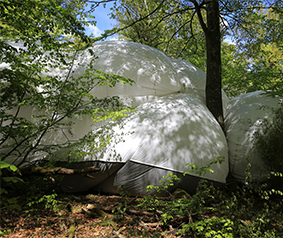
Gunilla Klingberg & Peter Geschwind
Tarpaulin, fans, survival bags. Variable size.
WANÅS KONST, Sweden, May 5 - Nov 3, 2019.
Pressed against tree trunks and branches, the sculpture is formed to align with the forest and makes negative space in nature visible. The surrounding tree branches create a monochromatic impression against the tarpaulin’s surface, through peepholes on the sides, we can see the shadow play of nature in the interior of the form.
Lifesystems – Nonspace is a development of a sculpture the artists created for the exhibition Not A Single Story I at Nirox sculpture park outside Johannesburg in 2018. There, they used a material intended for extreme situations—“Lifesystems,” a thin plastic that functions as a warming blanket for people in distress, combined with tarpaulins; here, the tarpaulin dominates. Everyday materials are a characteristic choice for them. We recognize these materials, but Geschwind and Klingberg use the familiar for new functions. The sculpture is monumental yet simultaneously temporary.
Curator Elisabeth Millqvist & Mattias Givell
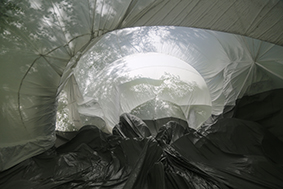
Gunilla Klingberg & Peter Geschwind
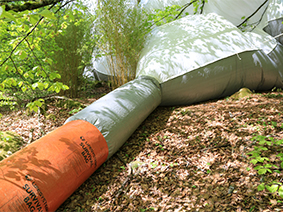
Gunilla Klingberg & Peter Geschwind
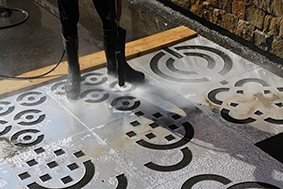
Spirit of the Woods (Silvia)
Art Encounters Biennial 2019, Timișoara, Romania. Sept-Nov.
Aluminium stencils, high pressure water washing.
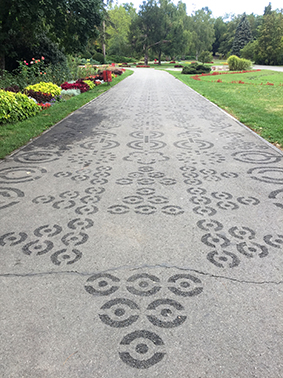
Spirit of the Woods (Silvia) can be found in multiple outdoor locations in Timisoara, as well as at the Tram Museum. The outdoor locations all hold a reversed graffiti image of simplified plant shapes. Created with cut out stencils showing a variety of rare plants in the Banat region, the shapes are generated by keeping the dirty part of an area otherwise cleaned with high pressure washing. Sensitive to time, and functioning as a module, the work can easily grow and create a meta-pattern throughout the city, and beyond. In this way it is both ephemeral and monumental, based on removal rather than adding more “stuff” to the world.
One of the outdoor locations is the Botanical Park, which was designed by the architect Silvia Grumeza in 1966 and completed in 1990. A flower pattern on the metal fence surrounding the park has served as an inspiration for Klingberg’s commission for the Art Encounters Biennial 2019. The fact that this is a work that can continue is underlined by the wooden racks holding the stencils, ready to be used in the future, and for now shown indoors as part of the biennial exhibition. As often is the case, the artist has created a work which is sensitive to the context at the same time as she pursues her long-term interest in patterns, continuity and transience.
(M L)
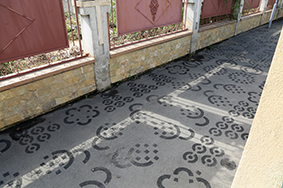
Spirit of the Woods (Silvia)
Curated by Maria Lind and Anca Rujoiu, “Art Encounters Biennial 2019 represents a source of inspiration for dialogue and reflection on borders and translations, something well known in Timișoara's Banat region. The Biennial includes the edges of visibility and invisibility, as well as an attentiveness to craft and the work of the hand.” Art Encounters engages a wide audience in debates about contemporary society and creates a dynamic platform in Romania for cultural exchange with the international art scene. Of the sixty invited artists, twenty artists are commissioned to create new artworks for this year's edition of the Biennial.

Spirit of the Woods (Silvia)
Aluminium stencils, wooden racks. At the Tram Museum.
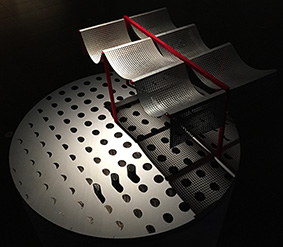
SPEKTAKEL, scale model. Stage, a public commission for Sörby elementary school, Gävle, 2018.
In collaboration with BRRUM architects.
Commissioner Gävle Municipality. Project management: Gävle Konstcentrum.
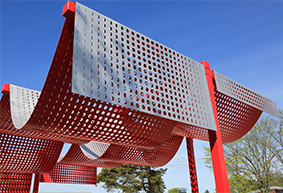


“Lifesystems”,
Not a Single Story – NIROX Winter Sculpture Exhibition, NIROX Foundation & Wanås Konst, Johannesburg, Southafrica, 2018. In collaboration with Peter Geschwind. Inflated sculpture. Material: thermal bags, rescue blankets, tarpaulin, electric fan.

“When Stillness Culminates there is Movement”,
installation at the 11th Gwangju Biennale South Korea, “The Eighth Climate ( What Does Art Do?)” 2016 at the Uijae Museum in the Mudeungsan natural park mountain area.
Detail. “Lunar Cycle”.

“When Stillness Culminates there is Movement” comprises an encompassing vinyl cut-out moon-cycle pattern “Lunar Cycle” applied on the windows of the entrance floor of the museum, filtering the incoming sun-light thus creating a raster of light-projections in the space.
At the museum entrance a solar-powered LED sign, with 7 horizontal bars disconnected from the electrical network, charging during daytime and fully lit at sunset. In the main hallway of the museum, one enters through a bambu curtain sculpture hanging from the ceiling, falling in a wave-like structure through the atrium, which leads us down to the display of cyanotype “Sun Prints” made at local fortune-tellers shops.
These works are largely influenced by the artist's research about Pungsu —the Korean form of geomancy— applied for the development of territorial planning and the construction of sovereign buildings. Klingberg's research about Pungsu comes as an iteration of her longstanding interest in the application of cosmology and superstition to quotidian material culture. The cyanotype “Sun Prints, per example, where made by applying sun-sensitive photographic paper to the storefronts of Gwangju Saju shops (fortune-tellers), where the sunlight registered the local window advertisements.
Klingberg's extreme sensibility to energy as a currency flow circulating around us is attuned with the rhythms of the cosmos and the pace of nature, while recognizing the ritual and the spiritual in the private and ordinary, as well as the entanglement of these spheres with the most central workings of capitalism.
Margarida Mendes, assistant curator G B
Curator: Maria Lind.
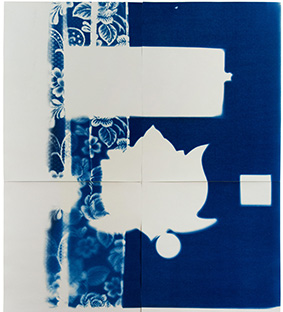
Sun-print, front door at Daesunsa, Gwangju, South Korea 2016 06 10. 11.40 - 12.55.
(Detail) Cyanotype print. 110 x 172 cm.
“When Stillness Culminates there is Movement”
installation at the 11th Gwangju Biennale South Korea, “The Eighth Climate ( What Does Art Do?)” 2016

Sun Print, front window at Hoam Saju Jakmyeong, Gwangju, South Korea. 2016 06 07. 15.20-16.20.
Cyanotype print 165 x 172 cm. 2016.

Lunar Cycle, 2016, cut-out vinyl, 11th Gwangju Biennale South Korea.

Recharge, 2016, solar-panel, LED light-tubes, batteries, variable.
“When Stillness Culminates there is Movement”,
installation at the 11th Gwangju Biennale South Korea, “The Eighth Climate ( What Does Art Do?)” 2016 at the Uijae Museum in the Mudeungsan natural park mountain area.
http://www.the8thclimate.org/
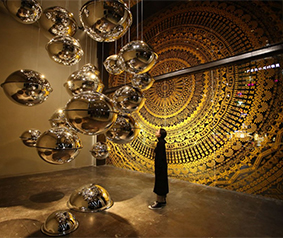
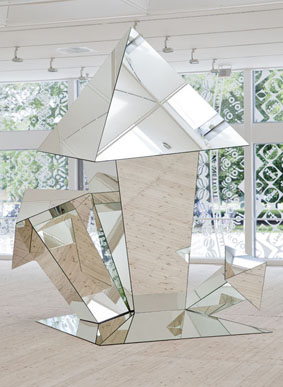
Exit, mirrorglas, wood. H: 280 x 180 x 180 cm.
Malmö Konsthall, Sweden 2014. Photo: Helene Toresdotter
¨In her exhibition at Malmö Konsthall Gunilla Klingberg allows the cosmic to meet the everyday, the well known to meet the mystical. This exhibition contains new works but also ones created for totally different locations that are reactivated here within Malmö Konsthall’s architecture.
www.konsthall.malmo.se
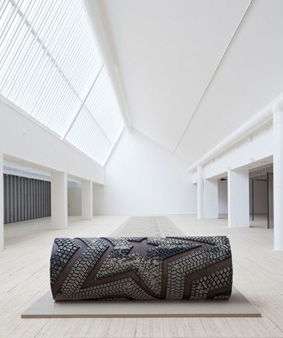
A Sign in Space, steel cylinder, truck tires, sand, printed documentation. Lunar cycle, silk-screen printed posters.
Malmö Konsthall 2014. Photo: Helene Toresdotter
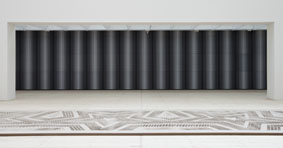
A Sign in Space, steel cylinder, truck tires, sand, printed documentation. Lunar cycle, silk-screen printed posters.
Malmö Konsthall 2014. Photo: Helene Toresdotter
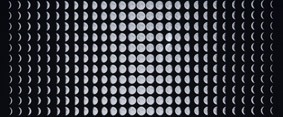
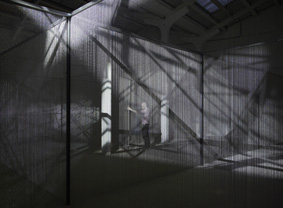
Parallelareal Variable, Eastside Project, Birmingham UK, 2013.
Ball chain curtains, steel structure.
Animated shadows by Peter Geschwind.
‘Parallelareal Variable’ reveals a powerful set of electro-magnetic bands of energy forming Eastside Projects. The artist hired a professional psychic dowser to divine the position of the Curry Lines within Digbeth running through the gallery. The representation of this grid through Eastside Projects turns the space into a flattened and repeating pattern, affecting the way a person navigates and exists in the space as a physical representation of the effects of the energy lines.
Photo: Stuart Whipps
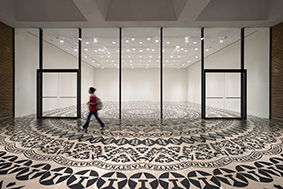
Wheel of Everyday Life, Rice Gallery, Houston, Texas, USA, 2013.
A large-scale, circular pattern in self-adhesive vinyl on floor and windows. Rice Gallery
Photo: Nash Baker
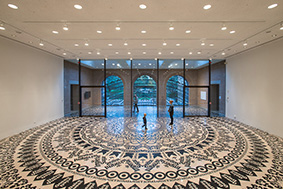
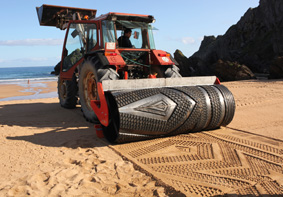
Sense & Sustainability, Art biennale, Urdaibai, Spain, 2012.
A graphic star pattern is impressed as a relief on the sand at Laga Beach during low tide. As the tide rises, the pattern gradually disappears. The pattern is composed with fragments of truck tires, mounted on a cylindrical steel template and attached to the beach cleaner’s tractor. Following the lunar and tidal calendar, the pattern is remade across the beach at every possible low tide. The work is performed on dates when the tidal calender is synchronized with the the beach cleaners early morning working schedule.
Dates:
On morning hours (9-12 am): 19th, 20th, 30th and 31st July. 1st, 2nd, 14th, 15th, 16th, 30th and 31st August. 14th and 15th September.
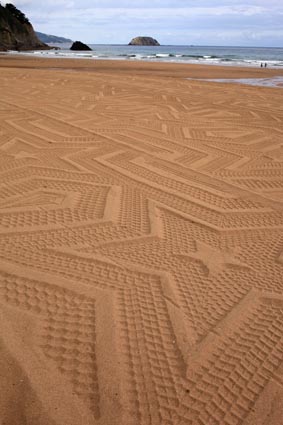
A Sign in Space. From July the 21st to September 23rd, the Urdaibai Biosphere Reserve (Basque Country) will serve as the scene of the international contemporary art project Sense & Sustainability, curated by Alberto Sánchez Balmisa and organized by the Fundación 2012 Fundazioa.
Sense & Sustainability includes 10 site specific installations developed by 10 international artists.
The list of participant artists includes: Lara Almarcegui (Zaragoza, Spain, 1972), Liam Gillick (Aylesbury, UK, 1964), Carlos Irijalba (Pamplona, 1979), Gunilla Klingberg (Stockholm, Sweden, 1966), Maider López (Donostia, Spain, 1975), Rafael Lozano-Hemmer (México DF, México, 1967), Renata Lucas (Ribeirão Preto, Brasil, 1971), Oscar Tuazon (Tacoma, USA, 1975), Pieter Vermeersch (Kortrijk, Belgium, 1973) and Haegue Yang (Seoul, South Korea, 1971).
Every one of them has developed site specific works in very different urban, industrial and natural spaces that investigate critically not only about the Urdaibai’s physical territory and social, cultural and economic development, as well as the more traditional concepts used for the art in public spaces.
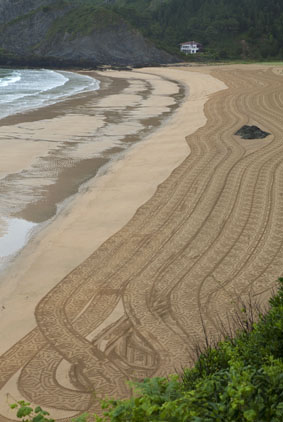

Patterns of Everyday Life, public commission trainstation Triangeln Malmö, Citytunneln. Commissioner: Malmö City. Opened Dec 2010.
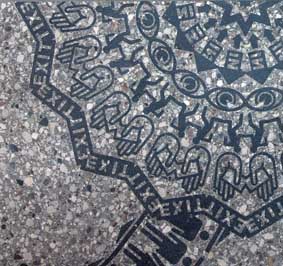
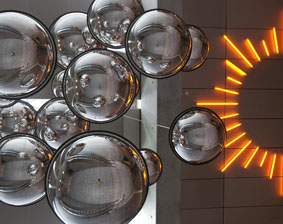
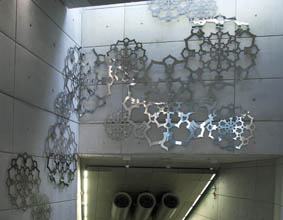
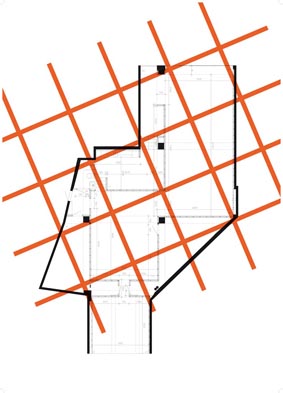
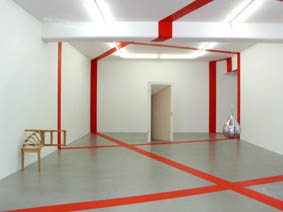
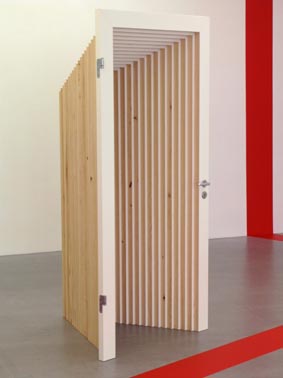

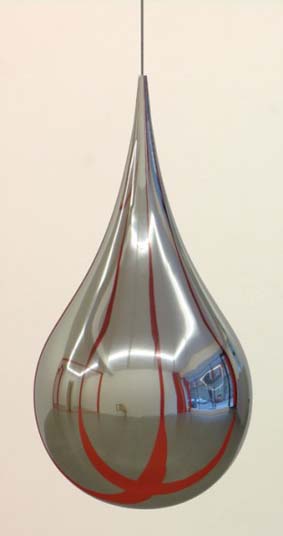
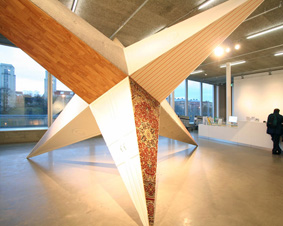
Mountable sculpture in wood, 9 x 5.5 x 4 m, wallpaper, oriental rugs, plastic carpets, wardrobe doors, sofa covering, stucco.
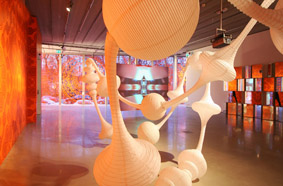

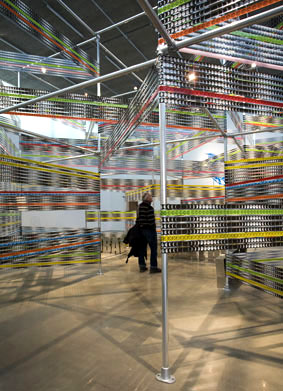
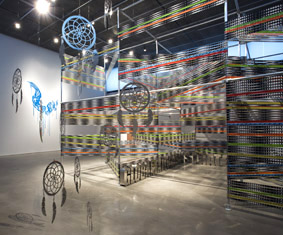
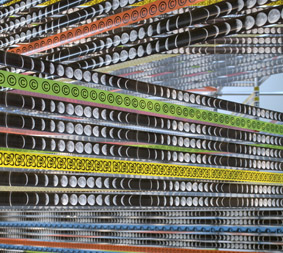
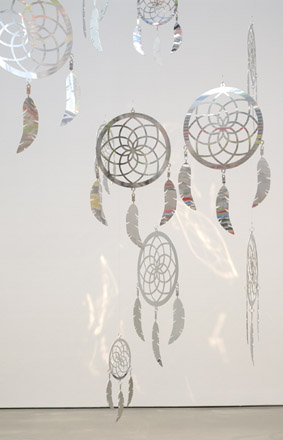

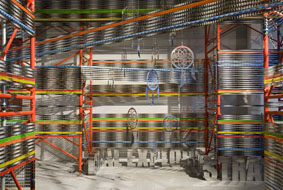
Cosmic Matter, scaffolding, printed tape, high-polished steel text and dreamcatchers. 10th Istanbul Biennial, IASPIS project, Istanbul, 2007.

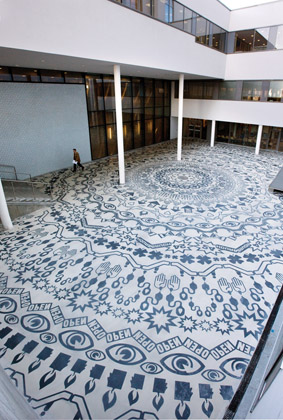
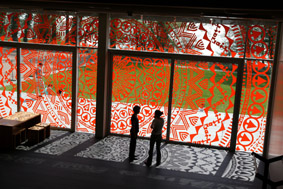

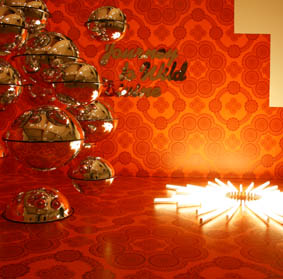
Silk-screen printed self adhesive posters (80 x 80 cm) on walls and floor, laser-cut texts in mirror-plexiglas, surveillance mirrors, strip lights Halo. The Moderna Exhibition, Moderna Museet, Stockholm, 2006.
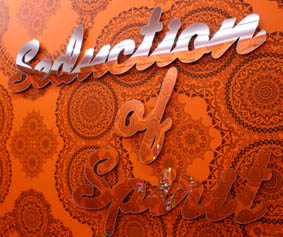
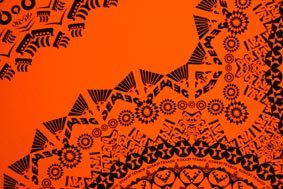
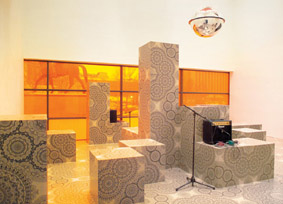
Repeat Pattern, installation view.
Silk-screen printed linoleum tiles, surveillance mirrors, orange film on window, sound installation Feedback Soundtrack with Marshall amplifiers, microphones, stands, effect boxes. Studio K, KIASMA, Helsinki, 2004.
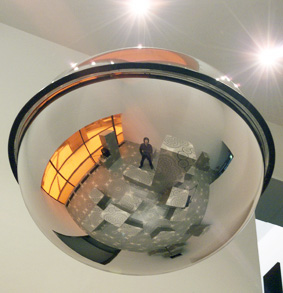
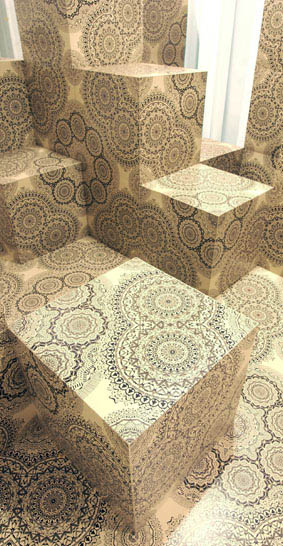

Brand New View, cut-out adhesive vinyl film,
Henry Dunker Culture Center, Helsingborg, 2003.
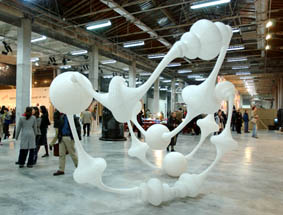
Transtube System, ricepaper lamps.
Palais de Tokyo - Site de Création Contemporaine, Paris, 2002.

Spar Loop, videoanimation on plasma screen.
Palais de Tokyo - Site de Création Contemporaine, Paris, 2002.
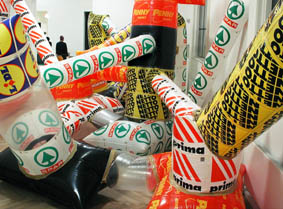
Cheap High, 2000-2003, plastic bags, tape, electric fans.
Gunilla Klingberg and Peter Geschwind.
Fundamentalisms of the New Order, Charlottenborg, Copenhagen, 2002.

New Delhi 2000-2001, video.
Gunilla Klingberg and Peter Geschwind, 2001.
Music by Momolake.
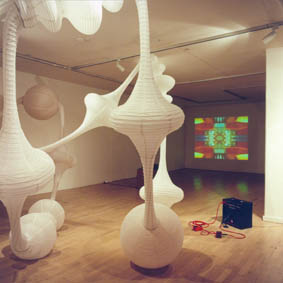
Non Stop Unfold, installation view, Transtube System - ricepaper lamps, Unfold - video, Feedback soundtrack - soundinstallation.
Index - The Swedish Contemporary Art Foundation, Stockholm, 2001.

Unfold, 2001, videostill.
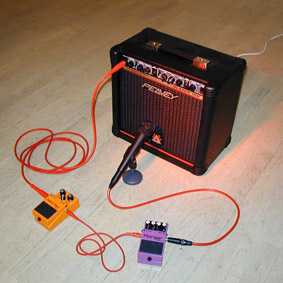
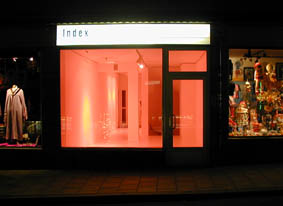
Index - The Swedish Contemporary Art Foundation, Stockholm, 2001.
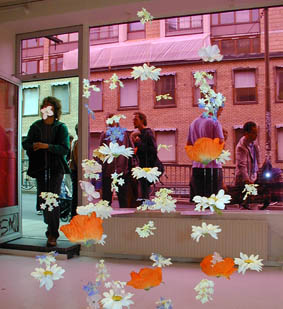
Polyester Bloom, polyester flowers, electric motor.
Index - The Swedish Contemporary Art Foundation, Stockholm, 2001.
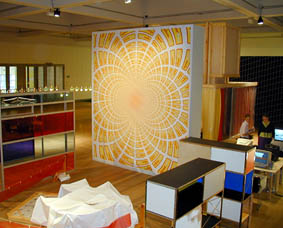
Sparspace, inkjet colour print on polethylene, 3,6 x 4,2 m, 2000. Installation view, What if – Art on the verge of architecture and design, Moderna Museet, Stockholm, 2000.
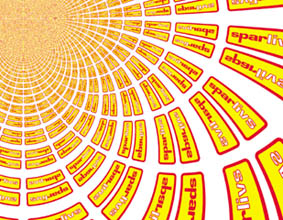
Sparspace, 1999 - 2000. detail.
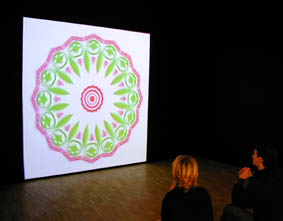
Spar Loop, video animation. All You Can Eat, Galerie für Zeitgenössische Kunst Leipzig, 2000.
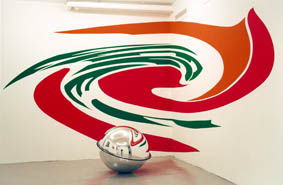
Seven Eleven Twist, wallpainting (6 x 3 m), two surveillance mirrors. Ynglingagatan 1, Stockholm, 1997.